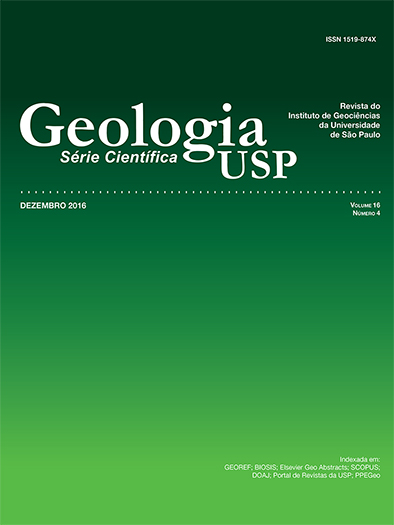A palynostratigraphic study of the Umrer Coalfield of Wardha Basin, Maharashtra State, Central India and its putative correlation with Indian and other Gondwanan areas
DOI:
https://doi.org/10.11606/issn.2316-9095.v16i4p99-117Keywords:
Umrer Coalfield, India, Early permian, Palynology.Abstract
The present work details the results of the palynological studies carried out in the Umrer Coalfield of Wardha Basin of Maharashtra State, Central India. The coalfield covers an area of 4 sq. km and is characterized by three coal seams designated as bottom, middle and top seams with partings. Statistical analysis of the palynomorphs from these sediments have revealed the dominance of radial monosaccate pollen grains of the genus Parasaccites and subdominance of non-striate bisaccate genus Scheuringipollenites in association with other typical early Permian taxa viz. Crucisaccites, Callumispora, Caheniasaccites, Brevitriletes, Tiwariasporis and Primuspollenites. This association characterizes the palynoflora of the upper Karharbari Formation of India on the basis of which the Umrer Coalfield has been assigned an early Permian late Sakmarian to early Artinskian age. It is further authenticated by the presence of the species Crucisaccites monoletus significant of the Karharbari Formation. Age deductions have also been made by correlations with similar assemblages from different basins in India and early Permian palynoflora from other Gondwanan continents some of which have been associated with radiometrically dated sediments.
Downloads
Published
Issue
Section
License
Authors who publish in this journal shall comply with the following terms:
- Authors keep their copyright and grant to Geologia USP: Série Científica the right of first publication, with the paper under the Creative Commons BY-NC-SA license (summary of the license: https://creativecommons.org/licenses/by-nc-sa/4.0 | full text of the license: https://creativecommons.org/licenses/by-nc-sa/4.0/legalcode) that allows the non-commercial sharing of the paper and granting the proper copyrights of the first publication in this journal.
- Authors are authorized to take additional contracts separately, for non-exclusive distribution of the version of the paper published in this journal (publish in institutional repository or as a book chapter), granting the proper copyrights of first publication in this journal.
- Authors are allowed and encouraged to publish and distribute their paper online (in institutional repositories or their personal page) at any point before or during the editorial process, since this can generate productive changes as well as increase the impact and citation of the published paper (See The effect of Open Access and downloads on citation impact).





